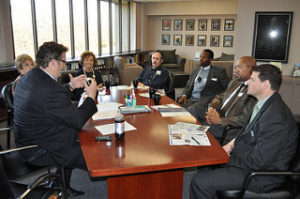 Last time I presented the first part of a discussion about the potential for boards as positive resources for community engagement. Here is the rest of the text.
Last time I presented the first part of a discussion about the potential for boards as positive resources for community engagement. Here is the rest of the text.
Getting to Yes
Since the inertial tendency of a nonprofit arts board may be ambivalent (or worse) toward community engagement, it is important to develop a strategy for developing enthusiastic support. The first step is to identify and then enter into preliminary discussions with current board members who are either already in favor of stronger community ties or seem willing to consider the position. (This is also the first step when considering a similar effort with arts organization staff members.) When ready, these board members will be able to provide guidance and to lead the process of educating the full board.
Advocating for community engagement should begin with clear explanations of what community engagement is and addressing misconceptions about it. Beyond that, the board needs to understand the rationale for an arts organization pursuing a community engagement agenda. Generally, the reasons fall in one of two categories: fostering sustainability and achieving far greater relevance. The former addresses the social and economic challenges that demand broadening the organization’s reach into the community; the latter the potential for significantly increased support. Since these could be construed as “sticks” and “carrots” arguments, as much focus as possible should be placed on the “carrots”–the excitement and expanded influence that community engagement can generate. In addition, reassurance that the entire organization will not be radically changed overnight is critical. The process of effectively developing relationships with new communities demands time and programming necessarily follows that process. As a result, best practice in community engagement demands slow, incremental change.
When the majority of the board has become convinced of the value of community engagement, it is important for there to be a public commitment to engagement. When new communities meet representatives of arts organizations they often assume the sole intent of the organization is to get them to buy tickets or make donations. That is many people’s experience with the arts. Successful community engagement needs to be based on mutual benefit. An official statement of the organization’s reasons for engaging and a commitment to mutuality can be a starting point for building trust. Sample wording for such a statement can be found here.
The Vision Thing
Articulating organizational values, vision, and mission is one of the most important responsibilities of nonprofit boards. It is an aspect of board governance that has the potential to energize every member and galvanize them into passionate commitment that spills over into all board functions. Enlisting the board in establishing community engagement as a strategic priority for the organization has the potential not just to support engagement but to make the board more effective in everything it does.
Partners in Engagement
Finally, it is valuable to include the board as partners in the ongoing process of engagement. Members should have input into the plans and be utilized as relationship builders. Where they have their own community connections they can lead. In other cases they can assist in developing and maintaining relationships with new communities. This is particularly important since staff members do not have the time to do much more than (at best) coordinate such work.
The board of directors is a legally required element of nonprofit organization management. It can be viewed as an obstacle to ignore or work around or it can become a resource to employ in the service of mission of the organization. It will be far better for the health of the nonprofit and the work of community engagement if its members are enlisted in the service of engagement. They represent great potential in relationship building. Indeed, given the time-intensive nature of working with communities, they may be among the most important assets to employ.
Engage!
Doug
Photo: ![]()
![]() Some rights reserved by Michigan Municipal League (MML)
Some rights reserved by Michigan Municipal League (MML)
The full text of this essay can be found here.
